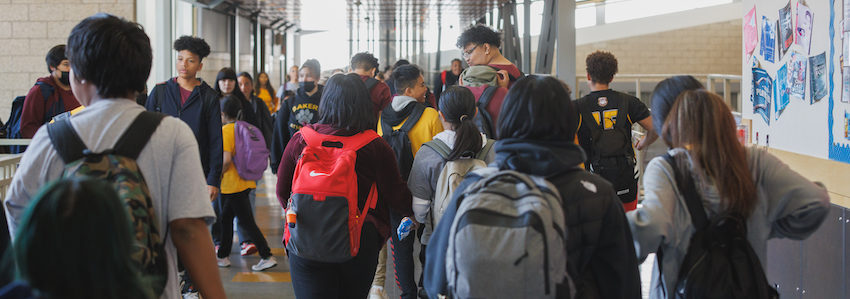
Schools are full of symbols. Walk the halls and take note of what’s on the walls and you will see what holds value historically, academically, and culturally. Who is represented? What perspectives are presented? Who decides what gets featured? I was recently involved in a situation that addressed this very issue.
Several years ago, our school started a “wall of kindness” as part of an initiative with Kind Bar and Harvard’s Making Caring Common project. There are challenges with efforts like these because students are encouraged to freely express their identities, which may offend, confuse, or upset others. It wasn’t long before we encountered an issue requiring us to have some difficult conversations.
We chose not to criticize this freedom of expression and, instead, we embraced it as part of the diversity that makes up our community. It wasn’t always easy, and we worked together to ensure no one was harmed by anything on our wall. Here is our story.
A triggering symbol on our wall of kindness
At the start of every year, our sixth-grade students create a brick representing their identity. They decorate them with symbols that can be anything from a video game character to a Black Lives Matter fist to a favorite food, beloved pet, rainbow flag, or something entirely different. Students are told about the origins and parameters of the project. They are encouraged to think deeply about how they want to be represented and, in a sense, memorialized on our wall. Once their brick is completed, it is mounted on the wall with the others. This wall is a predominant feature in our middle school hallway.
Two years before I arrived at the school, amid the height of COVID-19, political polarization, and racial tensions within our country, a Blue Lives Matter brick was placed on the wall. At that time, it was brought to the attention of members of the school’s leadership team and our diversity, equity, inclusion, and justice (DEIJ) director. They were all told that it evoked strong feelings and discomfort for students in our Black Student Union (BSU), a student group for Black students. Discussions and conversations were had, and it was determined that the brick would remain. However, there wasn’t clear communication about this decision and the BSU students assumed the brick would be removed.
Fast forward two years to my arrival and the arrival of our new DEIJ director. This issue resurfaced when our new director met with the BSU students, a group she was advising. To understand the situation, she began difficult conversations with students and the leadership team only to uncover confusion, mistrust, and lack of follow-through. It was a mess! Emotions were running high, and two years had passed since the initial talks, making it more difficult for all parties to know how to move forward. The brick needed to be addressed because students and staff in our community felt disrespected, hurt, and excluded by it.
Determining a path forward
Our DEIJ director, the person charged with navigating the situation, was new. Two months into the job, she, a woman of color, was asked to navigate a problem with multiple players while she still had limited social capital. She discovered that the student who had created the brick had never been spoken to about the situation and was now in eighth grade. The BSU government and student body had changed, but mistrust and feelings of exclusion remained. The leaders who took part in initial conversations thought there had been a resolution. They were put in a situation where they felt their integrity was challenged, and emotions ran high. It was a lot to manage. Here’s how we got through it:
1. Engaged in crucial, difficult conversations
We gathered as an academic leadership team and discussed how we felt about the issue, possible solutions, seen and unseen consequences, a communication plan, and future implications. Discussions were difficult and filled with strong emotions, but we were able to come up with a plan of action.
For ideas on how to have challenging talks in your school, read “Let’s talk about it: The right way to have hard conversations about race and ethnicity” and “7 tips for getting through difficult conversations.”
2. Gathered all perspectives
Our DEIJ director listened, reframed, and checked for understanding to ensure that she had all parties’ unique views. When individuals did not feel comfortable bringing forth their concerns or perspectives, she did so on their behalf, ensuring that she stayed true to their message.
3. Presented the situation and its implications to the student who created the brick
The young person who made the brick had no idea that the symbol they created and mounted on the wall had caused harm to others. They thought their brick signified the importance of first responders and did not know it was a counter symbol to Black Lives Matter. It was an important part of their identity and an important thing in their life.
The student was asked to consider solutions to the issue and create a plan to repair the harm caused by the symbol they chose to use.
4. Closed the communication loop
The student who used the Blue Lives Matter symbol returned with a solution; they decided to create another brick because they did not want to hurt anyone. They chose to use another symbol that still represented the importance of first responders, beyond just police officers.
This plan was communicated to all parties involved: the academic leadership team, the BSU, the head of our school, and all impacted students and faculty members.
5. Reviewed policies
Whenever a challenge or issue does not fit into an existing organizational policy, it is time to pause and re-examine it. What might you change? Why? Will there be any equity issues as a result? Who will a modified policy serve? Who will it protect? What will the intended and unintended consequences of the policy be?
Re-examining our policy on what could be included in the wall allowed us to ensure that we had a process that produces a consistent and equitable response. Our wall policies now state that if any member of our school community expresses concern over any symbol on the wall, we follow all the steps I’ve listed here.
6. Revisited the purpose of the wall and other symbols within our context
Our wall of kindness brought forward the issue of symbols in our context. What other things in our context did we want to challenge or remove? Did what was in our halls and classrooms represent our values and beliefs about inclusion? How might we start conversations to examine what is featured and by whom?
All schools have symbols on display that mean something. Some are historical, and new information about their origins may make those symbols hurtful to many today. Newer symbols can also be triggering. Either way, conversations can help address a path forward.
7. Educated ourselves
Situations like the one my school experienced with the Blue Lives Matter brick always reveal flaws or gaps in knowledge and understanding. We have a predominantly white leadership team, and the onus was on us to educate ourselves and dig into our thoughts, feelings, and understanding.
Listening with an open heart and mind, asking difficult questions, and researching solutions were a big part of this process. We knew we had to be vulnerable and open to change if we wanted our staff, students, and families to do the same.
Why we chose to share our story
Nothing is a problem until it is. In our case, we thought the issue of that sixth-grader’s brick had been resolved, with a solution found, but that was not the case. Students still felt excluded and hurt. We decided that if we were living our values of belonging and inclusion, we needed to lean into the difficult conversation and address the issue head-on.
When educators bring an equity and inclusion lens to our work, we can walk the halls with new perspectives and information and ask difficult questions about what and who we include—and do not include—in our schools. We choose to involve students in discussions and honor their voices in the process. This is part of the journey to creating an inclusive community. It’s difficult work, but it’s worthwhile and you can do it, too.







